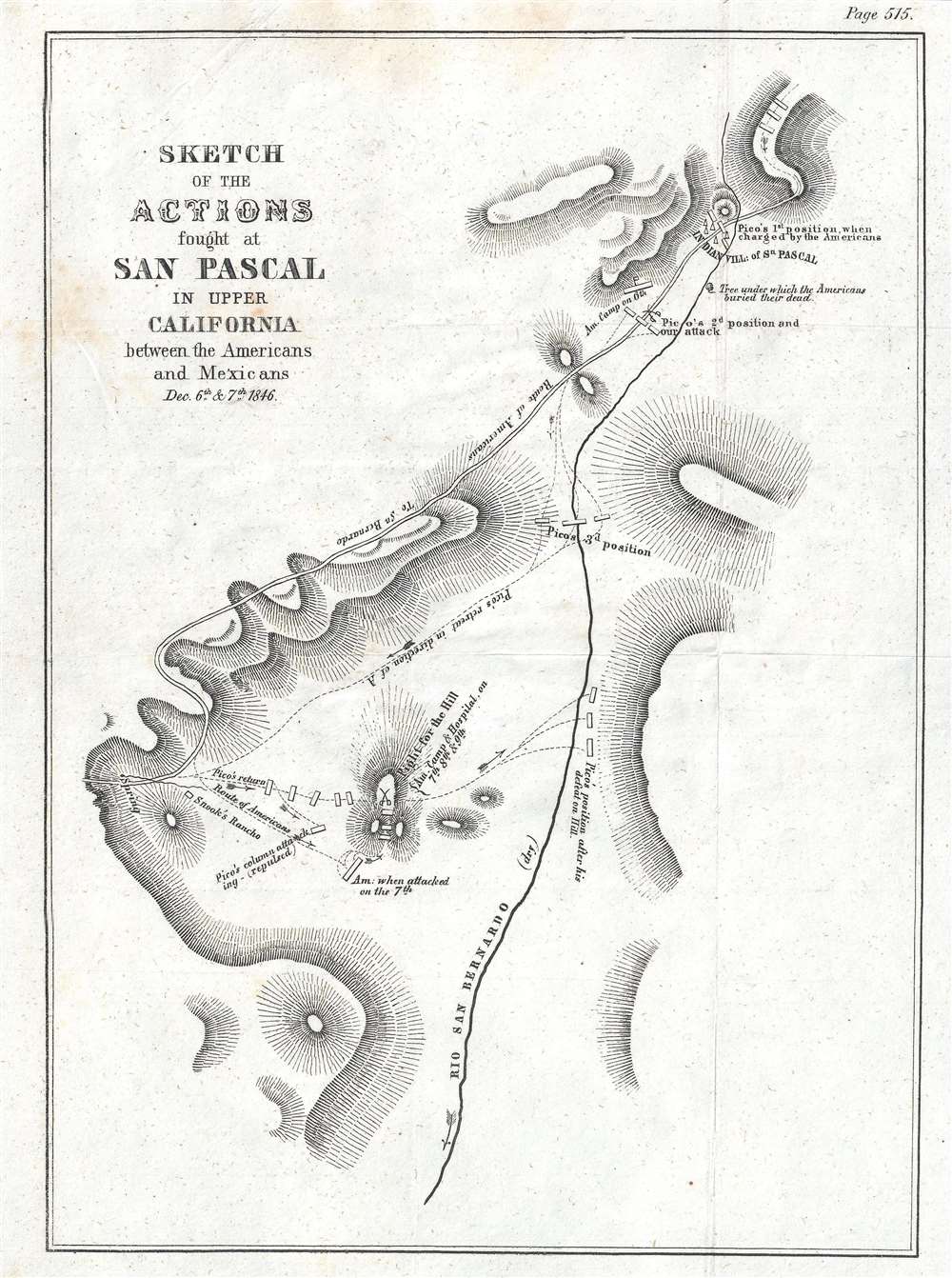This item has been sold, but you can get on the Waitlist to be notified if another example becomes available, or purchase a digital scan.
1847 Emory Map of the Battle of San Pasqual near San Diego, CA
SanPascal-usgovt-1847
Title
1847 (undated) 11.5 x 8.25 in (29.21 x 20.955 cm)
Description
The Battle of San Pasqual
The Battle of San Pasqual has the dubious distinction of being one of the few battles in American history where the victor is still debated. General Kearny and his men were originally dispatched from Fort Leavenworth, Kansas to capture Santa Fe, New Mexico and bring it under American influence. Kearny's force accomplished this goal without firing a weapon and established a civilian government in Santa Fe. Kearny's force was then ordered to California, a distance of over one thousand miles, and was equipped with 'devilishly poor' mules, some of which faltered within a day after leaving Santa Fe. Luckily, Kearny and his men eventually made it to California, where fighting had already ended, and John C. Fremont was already being prepared to be named governor. This meant that Kearny's force was no longer needed, thus he sent most of his men back to Santa Fe, before he and a small force continued on to San Diego. Kearny soon received word from Commodore Stockton that a group of insurgents, led by Andres Pico, was between him and San Diego. Although Pico by no means barred the only route to San Diego, Kearny decided to engage him. Fatally underestimating the fighting capability and prowess of the Californians, Kearny and his men attacked, after giving up the element of surprise. Pico's men outnumbered Kearny's by a significant margin, were mounted on much better horses, and were armed with lances and lassos. Kearny's men were exhausted from the journey from Santa Fe, were mounted on exhausted 'devilishly poor' mules, and the powder in their guns was damp from torrential rain, meaning that they would not fire. Thus, when Kearny's men attacked, at night, the force they were attacking was better equipped and outnumbered them, and the Americans attacked in a piecemeal, haphazard fashion, making it even easier for their superior opponents.Thus, it is not surprising that Kearny and his force suffered horrendously at the hands of Pico and his riders. No more than fifty Americans attacked that night, and of these twenty-one were killed and another seventeen were seriously wounded. Pico and his men had no desire to fight the attacking Americans. In fact, their original goal was simply to escape, because they believed that the scouting party that had unceremoniously wandered into their camp and announced itself presaged a much larger force. It was only when it became glaringly obvious that the American force was very poorly equipped and led that Pico and his men 'could not resist the temptation' to attack. The only reason that doubt exists as to who won this skirmish is that Pico, once he had soundly defeated Kearny and his men, elected to leave the battlefield. This went against the longtime Western military convention that the victorious force is the one that retains the field of battle, not the one that leaves. Thus, in the opinion of some, including Kearny himself, who was later promoted due to his report on the success he achieved here, Kearny and his men actually won The Battle of San Pasqual.
This map was based on a map drawn by William Hemsley Emory and published in a U.S. government report in 1847.
Cartographer
William Hemsley Emory (September 7, 1811 - December 1, 1887) was an American surveyor, civil engineer, and Army officer. Born in Queen Anne's County, Maryland, Emory graduated from the United States Military Academy at West Point in 1831, was assigned to the Fourth Artillery, and resigned from service in 1836 to pursue civil engineering. He returned to the army in 1838 to serve in the newly-formed Army Corps of Topographical Engineers. During the Mexican-American War, Emory served in the Army of the West under the command command of Stephen Watts Kearny. While serving with Kearny, he kept a detailed journal that was then published as Notes of a Military Reconnaissance from Fort Leavenworth to San Diego and soon became an important guidebook for the route to Southern California. After the war, Emory served as part of the team that surveyed the United States-Mexican border. When the American Civil War started, Emory was stationed in Indian Territory and immediately realized the likelihood that Confederates would capture him and his men. To avoid this, Emory quickly secured the services of Black Beaver, the famous Lenape warrior, to guide them out of the territory. Emory and his troops, on their way from Fort Washita to Fort Leavenworth, captured a number of their Confederate pursuers, which were the first prisoners taken during the war. Emory then served in the Army of the Potomac, in the Western Theater, and in the Shenandoah Valley Campaign of 1854. After the war, Emory held the post of commander of the Department of the Gulf during Reconstruction and, in September 1874, President Ulysses S. Grant ordered Emory to New Orleans, where he successfully negotiated a peace with the white supremacist paramilitary organization the White League, which led to the White League being disbanded. Emory married Matilda Wilkins Bache on May 29, 1838 in Philadelphia, with whom he had two sons, both of which served in the United States armed forces. Matilda Bache was Alexander D. Bache's sister. Alexander Bache was one of the most influential superintendents of the United States Coast Survey. More by this mapmaker...

